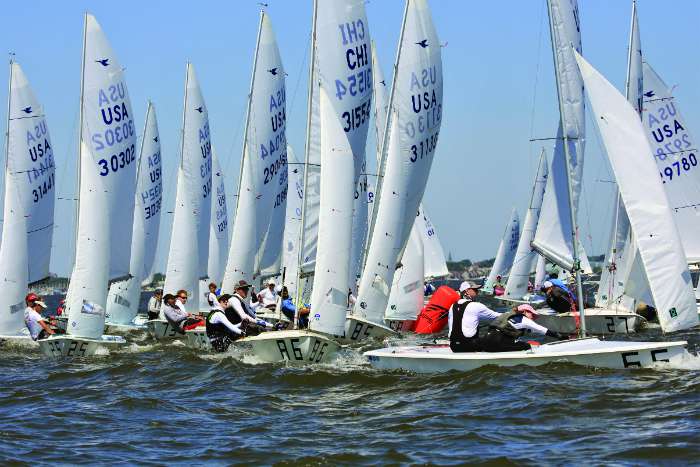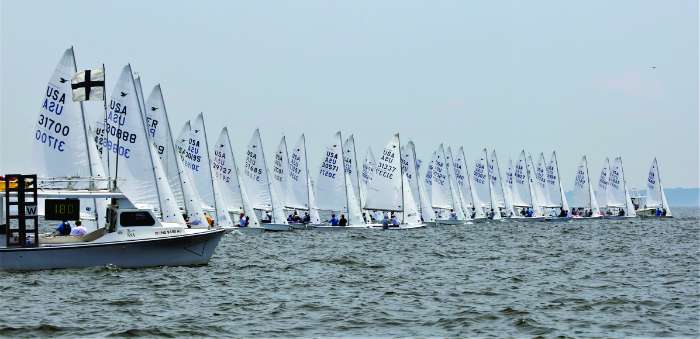Where Kindness May Be Your Most Strategic Sailboat Racing Strategy
The overall objective in sailboat racing is to cross the finish line first—to sail the course faster than your competitors. While there are endless decisions to make toward achieving that goal, simply sailing fast is a (and sometimes, the) primary key to success.

Sailboat racing is also supposed to be fun. Being tangled up with other boats, or being distracted by what’s going on around you, isn’t fun or fast.
What does “tangled up” mean here? It can be literal or figurative; from getting your shrouds meshed with another boat to a little bumper boat action to getting yourself in bad air, tangled is slow. Distractions are slow, whether it’s something that draws your focus away from driving fast or if it’s thinking about how you’re going to write up that protest form from the situation that just happened.
You can often avoid getting tangled up or distracted by being kind to your competitors. There are a few spots on the racecourse where the benefits of being kind to other boats can pay off not only for them but for you as well.
Before, during, and just after your start is a critical time where you need to focus on getting your boat off the line. It’s not where you are right at the start but 30 seconds after the start! Are you able to start with fairly clean air and a lane you can keep going in for a bit? That’s the goal. Yes, sometimes when you’re on final approach to the line, you need to do a bit of squeezing in to get your spot. But rarely do you need to screw someone else to do that. Swooping in from up the line or tacking super tight to leeward of a boat already set up on starboard makes them alter course and also restricts your maneuverability.
Remember Racing Rules of Sailing #16, which notes that a right-of-way boat must give the other boat room to keep clear—so that if you come in to a starting line too close to leeward to another boat, and as they pivot and try to head up to keep clear of you, the back hip of their boat hits your windward side, there’s a good chance you didn’t give them enough room. And then, they are possibly on your air (not good for you getting rolling fast as the starting gun fires), and you may have some time in the protest room ahead of you (a short- and long-term distraction). The alternative? Be a little kind, give them a little more room, and everyone’s happy.
Mark roundings are another classic part of the racecourse where kindness can help you get around the course more quickly. Coming in near the weather mark on port tack, there’s a starboard tack boat you could either cross or plant a tight lee bow on, maybe on layline but maybe not? Crossing them and tacking above them not only lets them keep on trucking, but also means you don’t have to pinch (= slow) your way to the weather mark. True, they might round the weather mark before you, but you’ll be tight on their tail and on their breeze, ready to pass them downwind.

The leeward mark is also a great spot where being kind and slowing down and letting the boats that are in front of you stay in front of you (for the time being!) can ensure greater success. Yes, of course, it would be super to have amazing boat speed and choose your positioning as you’re working down the leeward leg to get solidly overlapped inside so that you get to round that leeward mark or gate ahead of the folks you’re grappling with. But if it’s touch-and-go and you’ve only recently moved into a position where you might have a sketchy overlap, remember: RRS 18.2(e) says that if there’s a reasonable doubt that a boat obtained or broke an overlap in time, it shall be presumed that she did not.
But never fear, having to follow another boat around the leeward mark isn’t the end of the world. Far from it. If you see that situation developing, think three steps ahead to how you want to be sailing once you have rounded the mark. I’m guessing that “having rounded outside them, sailing in lower and in their dirty air” isn’t your goal! If you step on the virtual brake pedal a bit, you can set yourself up for a much better rounding by following their transom around rather than actually being outside them. Take down your spinnaker and put your centerboard down early; overtrim your main. Being kind to the other boat by not forcing yourself into a bad rounding will position you for success!
There are lots of other situations where giving other boats a little breathing room is kind to them—and potentially even more beneficial to you. Seek out those opportunities!
About the Author: SpinSheet Small Boat columnist for more than a dozen years, Kim Couranz has earned several national and world titles in Laser Radials (ILCA 6), Snipes, and Lightnings. She has also raced J/22s, J/24s, and Ynglings on an international level.




